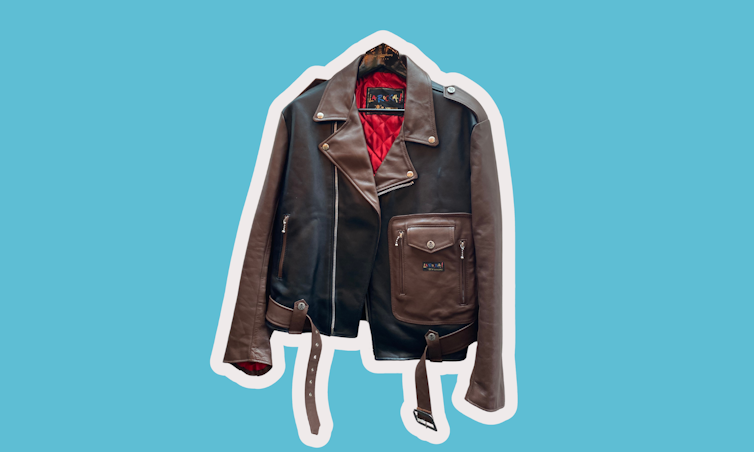We first met Martyn in 2013 when he was 54 and working as a professor at a UK university. He cut a sharp figure in a black two-piece suit, a bright red shirt with cufflinks, a matching tie and a pocket square. We were meeting to talk about fashionable mature men’s clothing habits.
We spent nearly two hours looking at some of Martyn’s most treasured fashion possessions and chatting about his interest in clothing and style. It’s not very often in research that participants are so keen and engaged, and Martyn’s passion for stylish clothing really shone through. This interest started early during his school years, when he used to unpick the seams of his school uniform.
Martyn was one of five British men included in our research, all aged between 54 and 63 from the baby boomer generation (people born between 1946 and 1964). Our first study, conducted in 2013, consisted of interviews and inventories of their wardrobes.
One of the insights from this was that, through years of interest and engagement with fashion, these men had accumulated considerable knowledge and expertise in how to best dress their bodies – and amassed large archives of both functional and iconic items of clothing.
As a result, the way they bought and wore their clothes was rooted in practical need and emotional connection, rather than unthinking accumulation or impulsive purchasing. This is something other people, including younger generations, could be inspired by.
Looking for something good? Cut through the noise with a carefully curated selection of the latest releases, live events and exhibitions, straight to your inbox every fortnight, on Fridays. Sign up here.
Now, almost a decade later, we’ve caught up with three of our interviewees again, conducting analyses and interpretations of their wardrobes as well as a series of interviews. While their clothing styles, and even some of the items, were pretty much the same as in 2013, the way they consume and engage with fashion has shifted.

Ania Sadkowska, Author provided (no reuse)
These men now shop less, prioritising quality over quantity. Although their often flamboyant appearance might suggest otherwise, this rationalised approach to purchasing is in step with fashion minimalism – the trend for slower and more considered clothing consumption, while rejecting the idea of clothes shopping as a leisure activity. As Ian, a retired 70-year-old businessman, reflected:
I think I probably have built up such a wardrobe of classic pieces that I really only need to buy some small additions now. Nothing major. If I do see some classic pieces that I love, I will still buy them even now. But I have certainly slowed down with buying, and looking at the [men’s fashion] magazines.
It’s important to note we were talking to the men again at a time of major changes in their lives. Retirement had brought shifts in their lifestyle, such as more leisure time and new hobbies. This meant they were dressing for different contexts – no longer the office, but for a day at home or evening down the pub.

Ania Sadkowska, Author provided (no reuse)
For these three men, aged 65 to 74, their changing bodies are also important to how they now experience clothes – from minor aches and pains to health issues that affect their mobility. As a result, their clothes are required to fulfil different types of need – balancing comfort with style, avoiding items that could restrict movement or impede confidence.
However, their commitment to expressing their identities through stylish clothing remains strong, flying in the face of commonly held assumptions that men stop caring about their appearance at a certain time in life.
Both our studies suggest the opposite. Indeed, when we spoke to Martyn again in 2024, his fashion sensibilities had only sharpened. He was the image of sartorial elegance, arriving for his interview in a checked suit accessorised with a trilby, tie pin and lapel clip, sleeve garters, a carved walking stick and handmade leather brogues. Martyn described his fashion choices as follows:
I’ve always got a smart shirt, reasonably smart trousers, proper shoes and, if it’s to be cold, a waistcoat with a pocket watch. And that’s me, sitting on my own, typing or just playing with the cat.
Or take Kevin, a 74-year-old retired lecturer devoted to the mod subculture’s clothing aesthetics, including sporting suits and tailored coats. His fashion archives consist of some incredible pieces that have been in his wardrobe for more than 20 years:
I used to wear [suits] all the time, irrespective of whether it was a formal occasion or work. That was my style for years and years – but less so now. My main social life revolves around my local pub, which is not a place really to get dressed up to go to – although I do, sometimes. I am fed up of wearing the same clothes.
Then he added, with a grin: “Once a mod, always a mod!”
Despite some major changes to their lifestyles, the three men have maintained their interest in clothing and its importance in expressing their unique identities – offering an interesting angle to the growing academic interest in menswear and men’s fashion. Their slower and more considered consumption of fashion presents food for thought in relation to the role and value of clothes in all stages of life.










